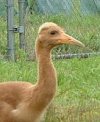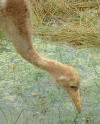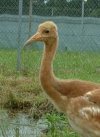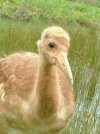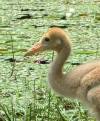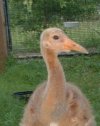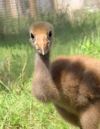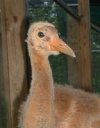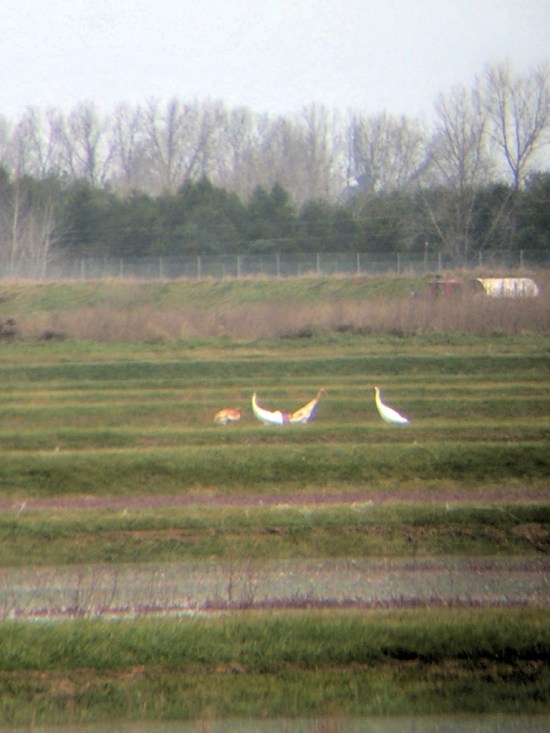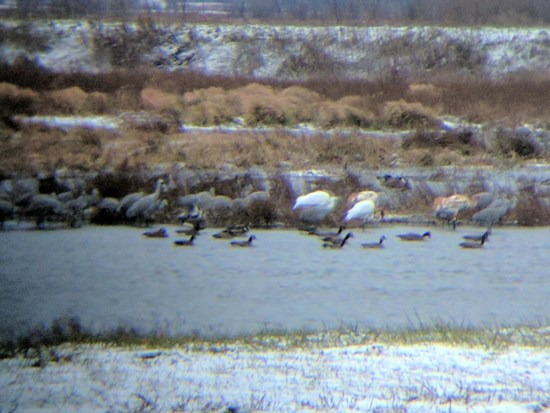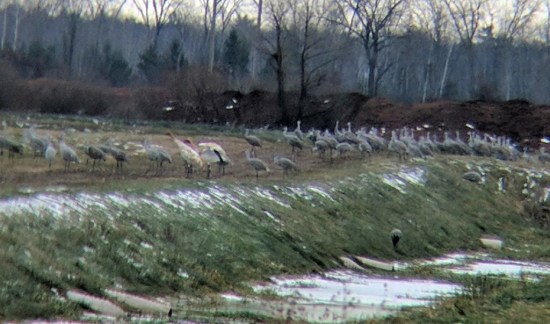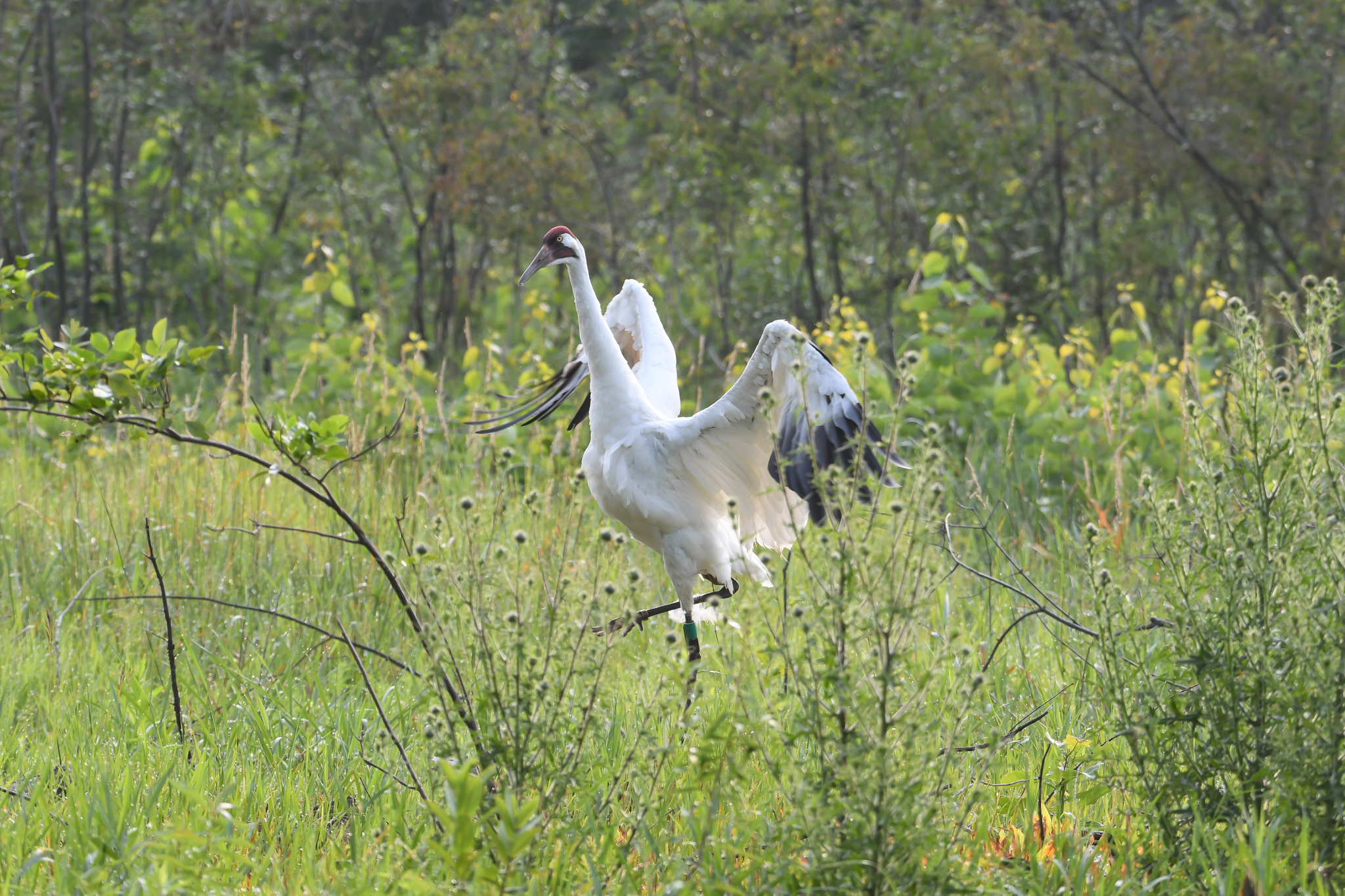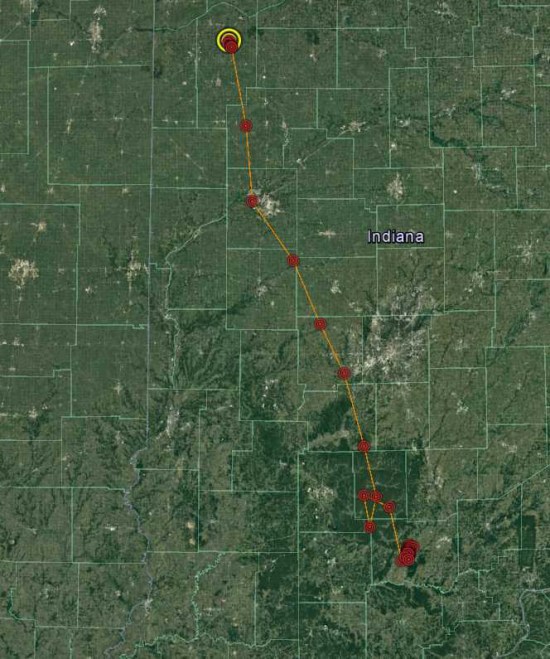About this year’s Whooping Crane chicks:
Twelve of this year’s 13 cranes were hatched and raised by adult cranes in a captive-breeding facility, where there was minimal human contact and no costumed handlers. The chicks were transported in September 2016 to the eastern flock’s summer range in Wisconsin. All but one were then released in the fall near selected wild Whooping Cranes. The thirteenth chick, W7-16, was hatched in the wild.
PR Crane #29-16 | Sex: Male | Hatch Date: May 13, 2016
Raised by Whooping crane parents at a captive breeding center in Maryland. Released September 24 along with PR colts #34-16 (F) and #39-16 (M) in Adams County near target alloparents Crane #24-09 and Crane #42-09 DAR. Young PR #29-16 and PR 39-16 stayed there. They first attempted to follow the target alloparents to their roost spot on the evening of October 10 but the youngsters turned back after flying a mile and a half. As of Oct. 23 the two colts, dubbed “Mutt” (#29-16) and “Jeff” (#39-16) by their observers Colleen and Brooke, were still foraging in and around a harvested ag field while hunters, harvesters, and trappers also used the land. Mutt is like the older brother, teaching and leading Jeff, the younger. Unfortunately, the target alloparents did not stay around long. To the team’s dismay, the two young cranes did not fly off to roost at night in the much safer nearby wetlands, but instead spent nights in the wide open fields at their Adams County release site. For weeks, they barely flew a few hundred yards. They mostly ignored the adults despite sharing the same area. Finally, On Nov. 15, adults #24-09 and #42-09 DAR dropped by to visit the two PR colts for the first time in weeks — just as the weather turned snowy and windy.
This time the adults got the colts to roost in water, and then the colts barely left the wetland! Adults #24- and #42-09 DAR tried their best to lead them away, but the colts stubbornly landed in their familiar cornfield when the adults took off and kept going south on the morning of Nov. 20. The colts showed more interest in wandering.
They had been surrounded by a flock of about 50 Sandhill Cranes since Nov. 21. As of Dec. 4, PR #29-16, with PR 39-16, was still happily foraging in Adams County, WI (and not chasing the Sandhills as often).
He finally began migration on December 7 along with buddy PR 39-16 and many Sandhill Cranes heading south. They were in Kendall County, IL late that evening. By Dec. 13 they were in Dyer County, TN, where they remained until migrating north in early to mid-April. The two buddies were reported before April 22 in Chippewa County, Wisconsin. If #29 remained with his buddy #39, they were wandering in May, and #39’s signal was last reported in Ward County, North Dakota!
These two males returned to Wisconsin in early October and were selected to have two female Parent-Reared chicks released near them. The release took place in Marathon County and while the foursome was observed together a few times, an official “adoption” did not take place. Male PR #29-16 and his pal PR #39-16 began heading south again on November 9th and by the 12th they had returned to their winter location from last year – in Dyer County, TN.
Spring 2018: At the end of March, 29-16 and 39-16 returned to Adams County Wisconsin where they’d originally been released in 2016. They associated with 11-15 and W3-17, but 29-16 was the first to leave the group. He moved to Necedah National Wildlife Refuge, where he remained for the summer.
Fall 2018: 29-16 has yet to be seen on fall migration. His last sighting was November 2nd.
Spring 2019: The remains of 29-16 were found at Necedah National Wildlife Refuge in May. It is likely that he died before fall migration in 2018. Cause of death is unknown.
Click here to jump to the top of this page.
PR Crane #30-16 | Sex: Male | Hatch Date: May 16, 2016
Raised by Whooping crane parents at the captive breeding center in Maryland. Released September 23 at White River Marsh in Green Lake County, near two pairs of adults. On October 7, PR #30-16 appeared to be bonding with adult male Crane #4-12 and female Crane #3-14 when the three of them flew off into White River Marsh and roosted together. Time passed and PR #30-16 and his new alloparents stayed together. Observer Joe Duff said, “So far, this association seems to be the only one working as it should.” Colt PR #30-16 was the only 2016 colt without a remote tracking device (he has a VHF transmitter), but also the only one to actually be spending consistent time with adult alloparents. On Nov. 6, young PR #30-16 left and took a flight with the other resident adult crane pair (male #4-13, who always showed a lot of interest in the young crane, and his mate #8-14) in White River Marsh, but the youngster soon left them to roost with his alloparents.
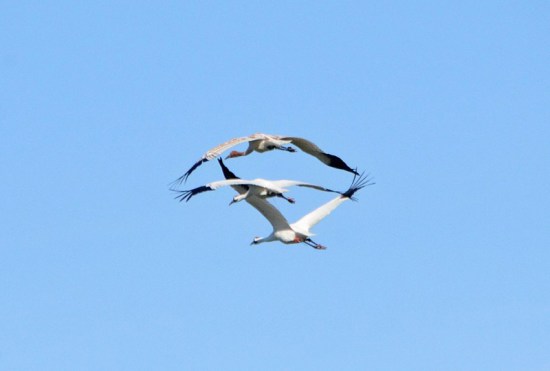
Whooping crane PR #30-16 in flight with #4-13 and #8-14. Photo: Doug Pellerin
The new family frequently used a single field from just after sunrise to dusk, still in White River Marsh, and PR #30-16 grew nearly as big as the adults.
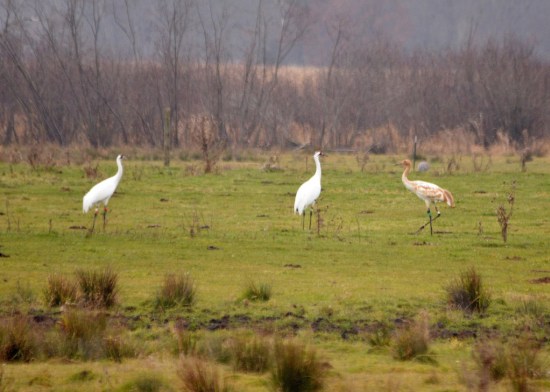
Whooping crane juvenile PR #30-16 on the right and adults #4-12 and #3-14 on the left. Photo: Doug Pellerin
Led by alloparents #4-12 and #3-14, the young colt began his first southward migration on December 7. By Dec. 13 the team confirmed that the family was in Floyd County, GA. They stayed together and later moved to Seminole County, GA. By March 1 the family was in Miller County, GA and next, moved to Kentucky.
The family completed spring migration back to White River Marsh on March 21. They have been spotted deep in the marsh, the adults close together and the juvenile PR #30-16 a few hundred yards off.
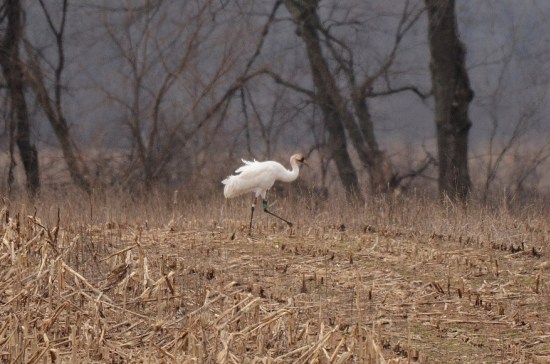
Parent-Reared #30-16 still has some brown on his head. Photo: Doug Pellerin
“They likely chased him away now that they are back home,” noted Operation Migration’s Joe Duff. “That’s a good sign that they may breed this year and produce their own offspring. They taught PR #30-16 how to migrate and to be wild, and maybe he taught them how to be good parents.” The juvenile was seen later, foraging in corn stubble with 2-year-old Whooping cranes #10-15 and & #11-15. He’s doing the normal thing for a juvenile returned to the nesting grounds: hanging out and exploring with other juveniles. During all of April, he was hanging out in Green Lake County, WI. He was often seen foraging with male whooper #5-12.
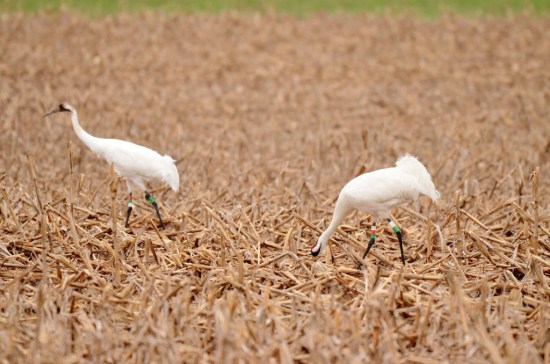
Male PR #30-16 (left) and male #5-12 near White River Marsh. Photo: Doug Pellerin
Fall 2017
Male #30-16 and his pal #5-12 found the seven costume-reared crane chicks in September one day. Over the next several weeks, these two adults would lead the seven youngsters back to their favorite roosting pond where they spent the evening roosting together. Eventually, they even spent time in the nearby field foraging.
Everyone was hopeful the two adults would lead these young cranes to St. Marks National Wildlife Refuge where they both typically spend the winter months. Unfortunately, on November 9th, both #30-16 and #5-12 began migration without the chicks!
St. Marks Refuge volunteers confirmed they were present IN the winter release pen on November 25th.
Spring 2018: In mid-March, 30-16 and 5-12 were spotted in southern Illinois as they made their return to Wisconsin, and they were back at White River Marsh on April 5. However, 30-16 was soon left on his own as 5-12 took 67-15 as his mate. 30-16 spent most of the summer by himself, until late August when he began associating with males 3-17 and 11-15.
Fall 2018: 11-15 moved to Adams County, but 30-16 and 3-17 continued to associate. In late October, the two joined pair 5-12 and 67-15. Trackers believed that the group of four would return to 30-16 and 5-12’s previous wintering ground at St. Marks National Wildlife Refuge in Florida, but in late November, 3-17 showed up at Wheeler National Wildlife Refuge in Alabama by himself. On December 5th, trackers confirmed that 30-16, along with pair 5-12 and 67-15, had made it back to St. Marks, where they spent the winter.
Spring 2019: Trackers first heard signals for 30-16 back at White River Marsh on March 27, along with many other birds. Hopefully he finds a new companion to spend the year with.
Luckily, 30-16 did find a new mate! He and female W3-17 began associating in late April. They are the first wild-hatched/parent-reared pair.
30-16 nested with new mate W3-17 at White River Marsh in April. This was the first nest between a parent-reared bird and a wild-hatched bird- the first nest where neither parent was raised by costumes! Despite the young ages of the parents, they produced a fertile egg. The pair was seen off nest in mid-May. Eggshell fragments were found on the nest, but no chicks were seen so it is inconclusive whether a hatch occurred.
Fall 2019: W3-17 and 30-16 spent the summer at White River Marsh in Green Lake County, Wisconsin. They were first observed on their wintering grounds in December, at Wheeler National Wildlife Refuge. They spent the winter here with other whooping cranes.
Spring 2020: W3-17 and mate 30-16 were first observed back at White River Marsh at the end of March. We assume the pair nested since W3-17 was seen alone and the two spent a lot of time in one area, but we were never able to confirm a nest.
Fall 2020: 30-16 and mate W3-17 left White River Marsh in December and went to Wheeler NWR, Alabama. They are wintering with other whooping crane pairs at the refuge.
Spring 2021: 30-16 and W3-17 appeared back at White River Marsh at the end of March and were incubating eggs on a nest less than a month later. They hatched their chick (the first to hatch at White River Marsh!), but it sadly went missing in the middle of May.
Fall 2021: 30-16 and W3-17 hung around in Wisconsin up until late November. They migrated down to Wheeler NWR in Alabama, and they have been associating with several other whooping cranes in the area.
Spring 2022: After spending the winter in Alabama, 30-16 and his mate, W3-17, migrated back to White River Marsh by the end of March. They were quick to nest shortly after their arrival and were seen incubating in early April. This nest unfortunately failed due to egg predation, and the pair did not attempt a renest. W13-17 and 30-16 have continued hanging out at White River Marsh since then.
Fall 2022: 30-16 and his mate W3-17 spent the rest of the summer on their territory at White River Marsh. During fall, W3-17 showed up on the wintering grounds at Wheeler NWR in Alabama without 30-16. We hope he will turn up soon!
Spring 2023: 30-16 was last reported in fall 2022. His mate returned to their territory but is now paired with a different male. He is considered to be long-term missing and presumed to be dead.
Click here to jump to the top of this page.
PR Crane #31-16 | Sex: Male | Hatch Date: May 21, 2016
Raised by Whooping crane parents at a captive breeding center in Maryland. Released September 22 in Marquette County after spending five days there in a temporary holding pen. Formed a bond with adult male #4-13 and female #7-14.

Parent-Reared #31-16 was released as the two adult cranes watched from the sidelines. Photo: Heather Ray
On September 23rd, PR #38-16 was released there too.

Brooke and Joe release PR #38-16. Photo: Heather Ray The adult pair foraged with both colts during the day. At night, the colts tried but still weren’t yet flying quite well enough to follow the adults to their distant roost site.

Time after time the two adults would try to lead the young cranes to a safe roosting location but they seemed unable to follow them in flight. Photo: Heather Ray
The possibility of adoption fell apart after adult male Crane #4-13 ended up stealing female #8-14, another male’s mate.
Meanwhile, older colt PR #31-16 daily urged the younger PR #38-16 to practice flying. Observers Heather and Jo-Anne reported that the two colts continued to do well, despite not having any adult Whooping Cranes with them. Each night they roosted on a great wetland a couple miles from their release field. During the day they flew quite a bit and foraged in nearby ag fields. The two young colts were still in Marquette County on Nov. 13, but after exploring, were found 10 miles to the south among a couple hundred Sandhill cranes. The pair of young cranes bopped around like they were in a pinball machine, giving Heather quite a chase to keep track of them. They had shared wetlands with as many as 1000 Sandhills, but were often seen alone during the day.

Parent-Reared Whooping cranes #31-16 & 38-16 in flight. Photo: Heather Ray
They seemed oblivious to cars and once walked in the direction of a coyote, drawn by curiosity rather than put off by fear. The two buddies, PR #31 and #38-16, remained in Marquette County, WI until departing on migration December 8. (A GSM email from #38-16’s tracking device placed him directly over Chicago at 1:50 pm that day.) Since Dec. 10 the two were in good habitat in Crittenden County, KY. On January 7, 2017, they ventured into northwest Arkansas for the rest of the winter.
Male PR #31-16 stayed after his buddy #38-16 was killed by a car around March 9. In mid April, #31-16 left Arkansas on migration and stopped short in Stephenson County IL, just south of the Wisconsin state border. He remained there several weeks. Then, on June 9, he finally returned to Wisconsin!
Over the summer this young male crane traveled with Sandhill cranes but eventually settled down in Winnebago County, WI.
Fall 2017: 31-16 migrated to northwest Tennessee
Spring 2018: On March 1, 31-16 was spotted back in Wisconsin! He wandered around a bit, but didn’t stay long- in early May, he was seen in Stephenson County, Illinois with young male 3-17! At some point in May, 3-17 left but 31-16 remained in Stephenson County throughout the summer.
Fall 2018: 31-16 remained in Illinois throughout November despite heavy snow, but in early December, 31-16 was spotted at Jasper-Pulaski Fish and Wildlife Area in northern Indiana. He didn’t stay long, as he returned to northwest Tennessee a few days later. He remained through the beginning of January, but surprised trackers by returning to northern Indiana on January 10th! He is currently still in Jasper County, Indiana.Spring 2019: 31-16 made a brief appearance in Wisconsin in April, but ultimately returned to Stephenson County, Illinois where he spent the previous summer.
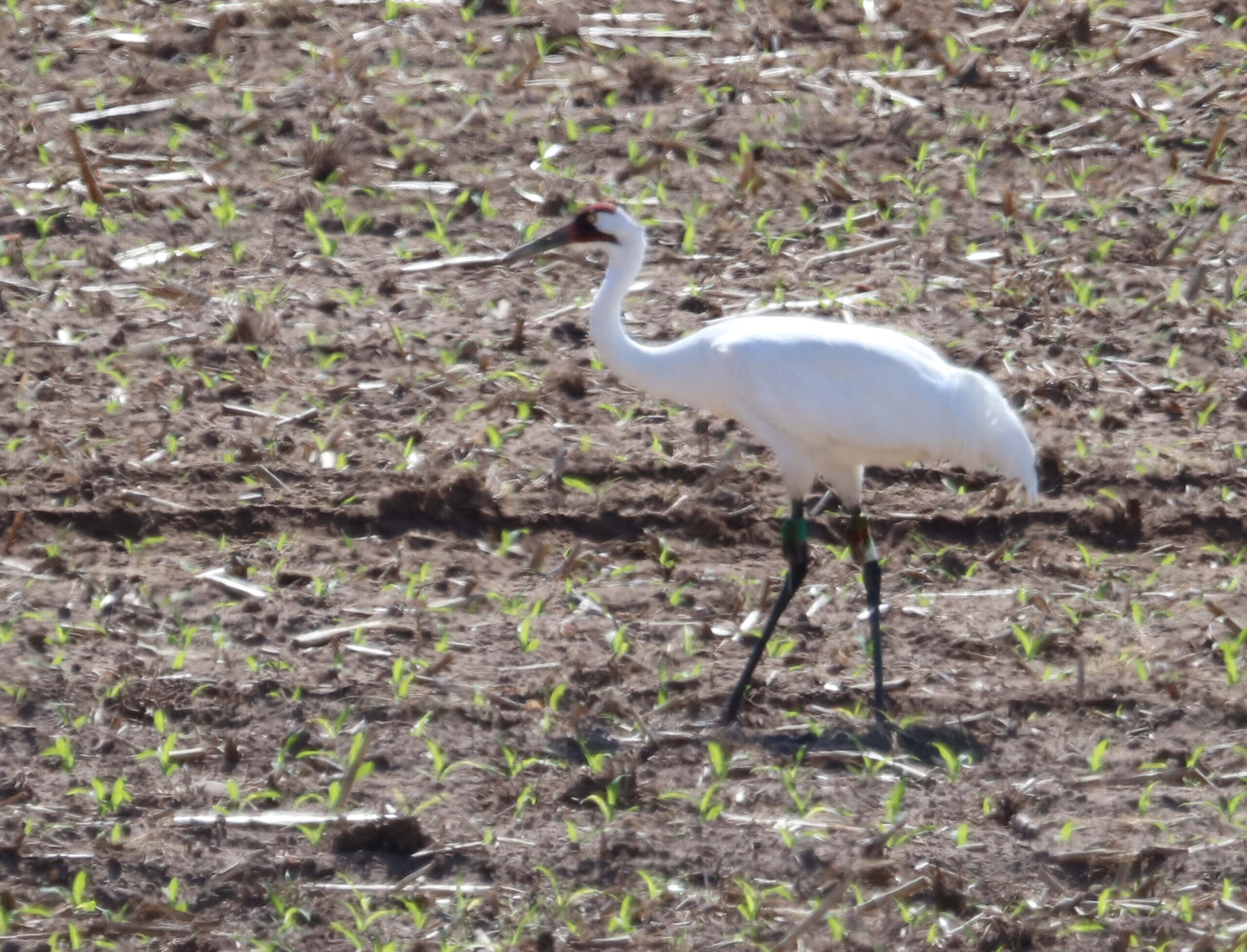
At the end of June, 31-16 surprised everyone by returning to White River Marsh in Wisconsin! Hopefully, he will stick around and maybe find a new buddy or two.
He ended up returning to Stephenson County, Illinois, where he spent late summer and fall.
Fall 2019: 31-16 spent some time in Green Lake County, Wisconsin, but ended up returning to Stephenson County, Illinois over the summer. In December, he made his way to Jasper County, Indiana. He spent the rest of the winter here.
Spring 2020: 31-16 was first observed at White River Marsh at the end of March. He has spent some time here, but has not been seen since the end of May.
Fall 2020: After not being seen since the end of May, pilot Bev Paulan found him still in Green Lake County, Wisconsin. He was seen there until October and then was seen alone in McHenry County, Illinois, in November. He then made his way to Jasper County, Indiana, where he has occasionally been seen amongst other whooping cranes in the area.
Spring 2021: 31-16 started migrating North from Jasper County, Indiana in late February and stopped in Dane County on the way back to White River Marsh. He’s been mostly by himself or with male 77-18 this summer.
Fall 2021: This fall, 31-16 was last seen in Green Lake County, Wisconsin, in late November. From there he migrated down to Jasper County, Indiana. In Indiana he’s been seen in the company of several other whooping cranes. Hopefully he finds a companion this year!
Spring 2022: This spring 31-16 migrated back up to White River Marsh in early March. Since then, he has spent most of his time alone. However, in March, he briefly spent some time with 85-21 and W2-21. He was also seen associating this spring with fellow bachelor 77-18. We hope that 31-16 continues associating with other whooping cranes and finds a mate soon!
Fall 2022: 31-16 spent much of summer and fall with other Whooping Cranes in Green Lake County. He returned to his normal wintering grounds in Jasper County, Indiana. He has been seen off and on with female 66-15, so we hope this winter they will finally stick together.
Spring 2023: 31-16 returned to Green Lake County, Wisconsin in early March. He was seen trying to pair with W3-17, but he lost her to W2-21. He was then seen in Waushara County but hasn’t been seen much this spring and summer. We hope he migrates safely this fall and finds a mate next spring!
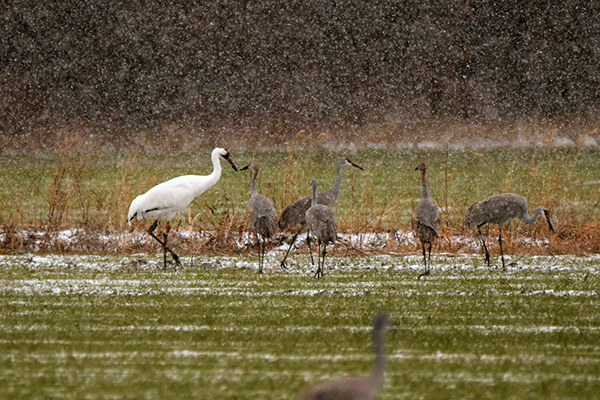
31-16 forages in light snow in Jasper County, Indiana. Russ Hawkins
Click here to jump to the top of this page.
PR Crane #32-16 | Sex: Female | Hatch Date: May 2016
Raised by Whooping crane parents at captive breeding center in Maryland. Released in Outagamie County near Crane #10-15 and Crane #11-15 on September 17. She associated with them but couldn’t keep up to fly with them to roost her first two nights of freedom. She was found dead September 19 in Outagamie County, WI, likely killed by a coyote seen earlier in the area.
PR Crane #33-16 | Sex: Female | Hatch Date: May 25, 2016
Raised by Whooping crane parents at captive breeding center in Maryland. Released September 24 with PR #37-16 (M) in Juneau Co near adult Crane #12-11 and Crane #5-11. She was still with the adults as of Oct. 18, but just two days later, PR #33-16 appeared to have started southward migration—alone! She was the first of the Class of 2016 to migrate. On Oct. 20 she flew a distance of about 120 miles across the Iowa border to a location south of Dubuque, Iowa. She remained in Jackson County, Iowa, until continuing to Miegs County, Tennessee and finally Citrus County, FL in December. She stayed in Citrus County, Florida, until mid-April, when #33-16 was in Carroll County, Illinois.
By the end of April she was back in Wisconsin’s Dane County! However, she didn’t stay, and she moved back south to Carroll County., Illinois the last week in May 2017. She spent most of June in Iowa before moving north to Murray County, Minnesota.
Fall 2017 This young female is staging in northwest Illinois along the Mississippi River.
33-16 was last seen in October 2017.
Click here to jump to the top of this page.
PR Crane #34-16 | Sex: Female | Hatch Date: May 2016
Raised by Whooping crane parents at captive breeding center in Maryland. Released September 23 with PR #29-16 (M) and PR #39-16 (M) in Adams County near adult Crane #24-09 and Crane #42-09 DAR. She became ill around October 5 and, unable to fly to escape, was killed by a predator on Oct. 7th.
PR Crane #37-16 | Sex: Male | Hatch Date: May 2016
Raised by Whooping crane parents at captive breeding center in Maryland. Released September 24 with PR #33-16 (M) in Juneau County near adult pair cranes #12-11 and #5-11. Both young cranes stayed with the adults but on Oct. 17 the remains of PR#37-16 were discovered in the woods near the Juneau County release site. Coyote predation is suspected.
Click here to jump to the top of this page.
PR Crane #38-16 | Sex: Male | Hatch Date: May 2016
Raised by Whooping crane parents at captive breeding center in Maryland. Released September 23rd in Marquette County where PR #31-16 had also been released. Observers Heather and Jo-Anne reported that older PR #31-16 daily urged the younger PR #38-16 to practice flying. The two colts continued to do well, despite not having an adult Whooping Cranes with them. Each night, they roosted on a great wetland a couple miles from their release field. During the day they flew quite a bit and foraged in nearby ag fields. The two young colts were still in Marquette County on Nov. 13 but, after exploring, were found 10 miles to the south among a couple hundred Sandhill cranes. In recent weeks the pair of young cranes has been bopping around like they’re in a pinball machine, giving Heather a chase to keep track of them. They were active but didn’t really have a direction yet. They had shared wetlands with as many as 1000 Sandhills, but were often seen alone during the day. They seemed oblivious to cars and once walked in the direction of a coyote, drawn by curiosity rather than put off by fear. They stayed in Marquette County, WI until departing on migration December 8. (A GSM email from #38-16’s tracking device placed him directly over Chicago at 1:50 pm that day.) They stayed in good habitat in Crittenden County, KY until January 7, 2017, when they ventured into Poinsett County, AR, for the next several weeks.
Around March 9, PR #38-16’s lack of fear around cars ended his life when he was struck and killed on a road in NE Arkansas.
PR Crane #39-16 | Sex: Male | Hatch Date: June 1, 2016
Raised by Whooping crane parents at captive breeding center in Maryland. Released September 24 with PR colt #29-16 (M) in Adams County near target alloparents: Crane #24-09 and Crane #42-09 DAR. The two PR colts first attempted to follow the adults to their roost spot on the evening of October 10 but the tired youngsters turned back after flying a mile and a half. As of Oct. 23 the two colts, called “Mutt” (the older #29-16) and “Jeff” (the younger #39-16) by their observers Colleen and Brooke, are still foraging the harvested fields.
Unfortunately, the target allo-parents did not stay around long. To the team’s dismay, the two young cranes did not fly off to roost at night in the much safer nearby wetlands, but instead spent nights in the wide open fields at their Adams County release site. For weeks, they barely flew a few hundred yards. They mostly ignored the adults despite sharing the same area. Finally, On Nov. 15, adults #24-09 and #42-09 dropped by to visit the two PR colts for the first time in weeks — just as the weather turned snowy and windy. This time the adults got the colts to roost in water, and then the colts barely left the wetland!
Adults #24-09 and 42-09 tried their best to lead them away, but the colts stubbornly landed in their familiar cornfield when the adults took off and kept going south the morning of Nov. 20. The colts did not go back to the wetland, but they showed more interest in wandering. They had been surrounded by a flock of about 50 Sandhill Cranes since Nov. 21. As of Dec. 4, PR #39-16, with PR #29-16, was still happily foraging in Adams County, WI).
He was gone on the morning of Dec. 7, off on migration with buddy #29-16 and many southbound Sandhill Cranes. They were in Kendall County, IL late that evening. By Dec. 13 they were in Dyer County, TN, where they remained until migrating north in early to mid-April. The two buddies were reported before April 22 in Chippewa County, Wisconsin, and were still there as of May 1. Then #39 (and likely #29, his buddy) decided to wander—to Ward County, North Dakota.
These two males returned to Wisconsin in early October and were selected to have two female Parent-Reared chicks released near them.
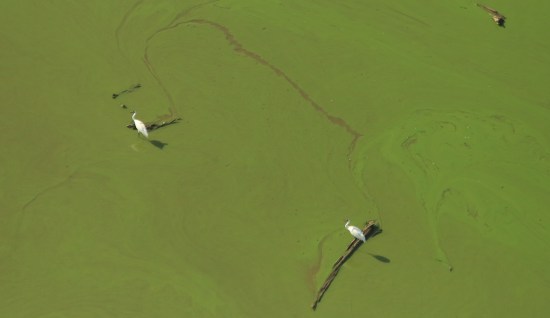
Two male Whooping cranes 29-16 & 39-16 in Marathon County, WI. Photo: Bev Paulan, Wisconsin DNR
The release took place in Marathon County and while the foursome was observed together a few times, an official “adoption” did not take place. Male 29-16 and his pal 39-16 began heading south again on November 9th and by the 12th they had returned to their winter location from last year – in Dyer County, TN.
Spring 2018: At the end of March, 39-16 and 29-16 returned to Adams County Wisconsin where they’d originally been released in 2016. They associated with 11-15 and W3-17, but eventually the others moved on, and just 39-16 and W3-17 ended up spending the summer together.
The last visual sighting of 39-16 was on August 8. After trackers noticed that his radio signal wasn’t moving, but they continued to not be able to see him, they investigated and found his remains. Cause of death is unknown.
Click here to jump to the top of this page.
PR Crane #69-16 | Sex: Female | Hatch Date: May 21, 2016
Raised by captive crane parents at Wisconsin’s ICF and released in Jefferson County, WI near adult Crane PR #14-15 on Oct 7. Even though it is likely she saw Crane #14-15 and also two Sandhills, PR #69-16 didn’t attempt to land near them. She did well, foraging and flying around enough to go from one field to another. She was in the fields on her own from Oct. 10. On October 25, signals from her tracking transmitter showed she had migrated as far as northern Indiana, following a pair of Sandhill Cranes to Jasper-Pulaski NWR. She was seen in Jasper County, Indiana on October 25 and then turned up at Wheeler National Wildlife Refuge in north Alabama on November 10, where she spent all of December associating with adult cranes #1-11 and #59-13 DAR at Wheeler NWR in Alabama. Come spring, she left Wheeler NWR, presumably with adults #1-11 and #59-13, for northwestern Indiana, and next showed up in Will County, Illinois. She continued moving around a lot, but kept heading north and reached Racine County, Wisconsin! She was then with 2-year-old #65-15, a DAR female who knows where “home” is. She spent all of April associating with female 65-15. These two moved around and even made a trip south to northwestern Indiana, then back to Fond du Lac County, Wisconsin.
Fall 2017 – By early fall this young female had moved south to Walworth County, Wisconsin and was seen loosely associating with young male Whooping crane #20-15. By November 22nd, she appeared at Wheeler National Wildlife Refuge in northern Alabama.
Spring 2018: On April 6, 69-16 was seen on her way back to Wisconsin, and on April 26, she was sighted at Necedah National Wildlife Refuge! She moved south in Juneau County and began to associate with males 12-09 and 16-12. By the end of the summer, 69-16 and 12-09 were being seen more frequently on their own, and 16-12 was often completely alone. Next year 69-16 will be old enough to nest, and it seems 12-09 wants to be her mate!
Fall 2018: 69-16 and 12-09 migrated to Gibson County, Indiana in November. 16-12 did not migrate with them.
Spring 2019: Satellite data for 69-16 shows that she arrived back in Juneau County, Wisconsin by the end of March. 12-09 was seen with her shortly after. Will this new young pair nest this year?
69-16 and 12-09 were first seen nesting in late April. Unfortunately, the nest failed.
Fall 2019: 69-16 spent the summer in Juneau County, Wisconsin with male 16-12 and 12-09. By mid-November, she arrived at Goose Pond in Indiana. She spent the winter here and also traveled to Sullivan County, Indiana with other whooping cranes.
Spring 2020: 69-16 arrived at Necedah National Wildlife Refuge in mid-April. Shortly after her arrival, she and W10-15 were seen associating with each other. The new pair did nest, but they abandoned the nest due to black flies.
Fall 2020: W10-15 and 69-16 did not re-nest after their failed attempt in the summer but remained at Necedah NWR until fall migration. They were first seen at Goose Pond FWA, Indiana, at the beginning of November. They have been spending time there with a large group of young whooping cranes and other breeding pairs.
Spring 2021: W10-15 and 69-16 left their wintering area in Greene County, Indiana, in early March. They returned to Necedah National Wildlife Refuge and started nesting at the end of April. Their nest was striking because it was in open water as opposed to a marshy, vegetated area, and their chick hatched but was gone by mid-June.
Fall 2021: This fall, W10-15 was captured, banded, and fitted with a transmitter so that we can track him and his mate 69-16. From their territory at Necedah NWR, Wisconsin, W10-15 and mate 69-16 migrated down to their usual wintering grounds near Goose Pond FWA in Indiana. There they were seen associating with a large flock of whooping cranes. Unfortunately, 69-16 was found dead on the wintering grounds in Indiana in January. Cause of death has not yet been determined.
Click here to jump to the top of this page.
PR Crane #70-16 | Sex: Male | Hatch Date: May 26, 2016
Finally released in Marathon County, WI on November 16, 2016, after being held back in captivity to recover from an injured wing. After his exposure to humans during several captures for injections of antibiotics, the team is hoping he’ll do okay in the release program. He was released near target pair #65-15 DAR and PR #27-14. He associated some with the adult whoopers and some with Sandhill Cranes. By Dec. 8, all the Class of 2016 but PR#70 were gone. The two adults he was released with were already at their winter homes. Most of the Sandhill Cranes were gone and no more Whooping Cranes remained to show him the way south. The weather turned snowy and cold.
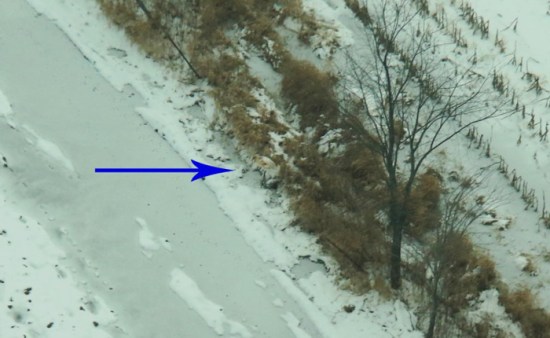
Whooping crane PR #70-16 in the snow.
On December 12, he was captured, checked for health, driven to Wheeler NWR in Alabama. He was released early December 14 by ICF’s Hillary Thompson near PR #69-16, with whom he was familiar.
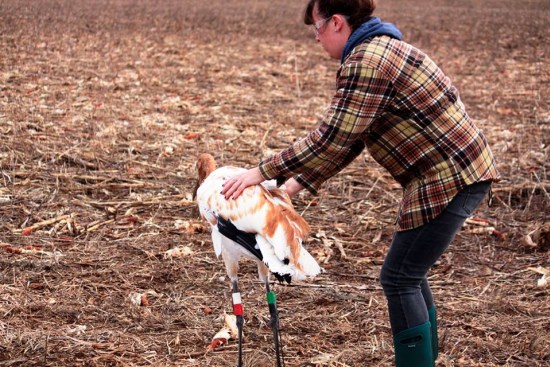
PR #70-16 is released by Hillary Thompson at Wheeler NWR.
He associated with #69-16 as well as adult Whooping Cranes on the refuge. He didn’t consistently spend time with the same adults, but has been seen with #18-11 and #14-15. He stayed at Wheeler NWR, but moved around more in April. He spends most of his time in Hardin County, TN and nearby Knox County, KY.
Fall 2017 – The male whooping crane did not come north for the summer and instead stayed in Knox County, KY. It will be interesting to see if he returns to Wheeler NWR where he wintered last year.
70-16 remained in Knox County, Kentucky. In early November, he had to be picked up by wildlife rehabbers as he had become caught in a fence. Unfortunately, his injuries were considered too severe to recover from, and he was euthanized.
Click here to jump to the top of this page.
PR Crane #71-16 | Sex: Female | Hatch Date: June 2, 2016
Raised by captive crane parents at Wisconsin’s ICF. Released September 30 at White River Marsh in Green Lake County, near two pairs of wild adults. Though young, she was a strong flyer from her first time airborne. She had only one encounter with her target adult pairs. Within a day or two, she left White River Marsh and headed southwest, stopping to roost in excellent habitat each evening. By Oct. 17 she was in Marquette County with Sandhills. The team hoped she would associate with Whooping cranes, but she didn’t. Until Dec. 7 she was still in Marquette County, WI. That day, a GSM email from her remote tracking device placed her in Lake County, Indiana—off on her first migration! On Dec. 9 her GSM signals came from Muscatatuck NWR in Jackson County, IN, where thousands of migrating Sandhill Cranes stop. She remained there until starting to move northward to Jasper County., Indiana on Feb. 21, 2017.
Amazingly, she and year-old sub-adult female #2-15 both landed at the exact same field on their northward migration back to Wisconsin—and it was good news for the juvenile to be with a sub-adult whooper who has made the migration before. Juvenile #71-16 stopped in Jasper County, IN until March 22nd. She completed migration back to Wisconsin before April 1 and moved from Grant County to Walworth County to Winnebago County as spring turned to summer.
Fall 2017: This 1-yr. old female Whooping crane appeared at Horicon National Wildlife Refuge in early October and was seen occasionally associating with male #63-15 DAR. Occasionally, she was turn up in the same field were parent-reared crane #38-17 was but the two didn’t really spent any time together. Heather managed to capture the following photograph showing the two in the same field, along with dozens of Sandhill cranes.

Adult female #71-16 on the right and the fawn-colored Parent-Reared crane #38-17 on the left. Photo: Heather Ray
In mid-November #71-16 did migrate south – along with male 63-15. Perhaps this is a new pair? We’ll have to keep watch of them over the winter and next spring to see if they return to the Horicon NWR area together!
Fall 2017: 71-16 separated from 63-15 and migrated by herself to Madison County in the Florida panhandle. Though other Whooping Cranes were nearby, she spent the winter alone.
Spring 2018: In early February, she moved north to Jackson County, Indiana on her way back to Wisconsin. At the end of March, she was back in Winnebago County, Wisconsin.
The last visual sighting of 71-16 was on June 5. After trackers noticed her radio signal wasn’t moving, but they continued to not get visual sightings, they investigated and found her remains. Cause of death is unknown.
Click here to jump to the top of this page.
W7-16| Sex: Male | Hatch Date: May 24, 2016
History: Chick #W7-16 hatched May 24 in the wild in Juneau County, WI to parents 29-09 and 12-03. By late August, he was the only remaining wild-hatched chick from the summer 2016 breeding season. On September 1st, #W7-16 was captured and banded. W7-16 and his parents remained throughout September in Juneau County. The young colt gained strength every day as migration time grew nearer.
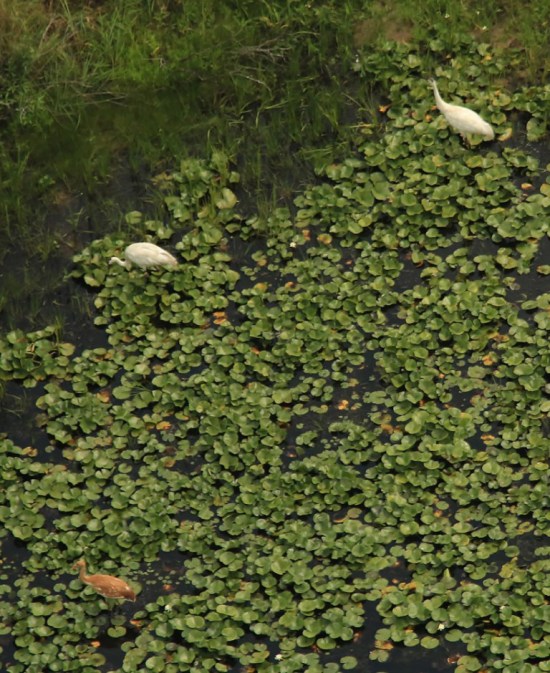
W7-16 with parents 29-09 and 12-03 in early August. Photo: Bev Paulan, Wisconsin DNR.
Fall 2016: Young W7-16 was last seen with parents in Juneau County on September 27 and his remains were found on October 11. Cause of death is suspected to be predation, due to tracks and scat in the area.
Click here to jump to the top of this page.

